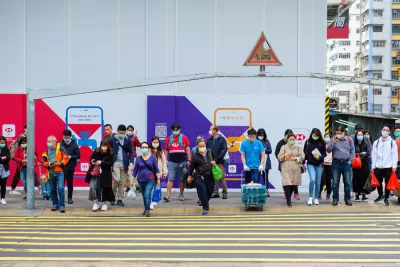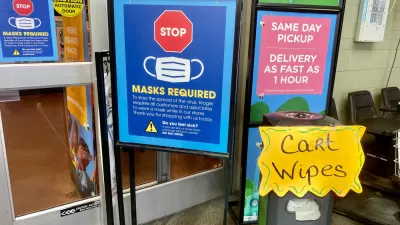Hong Kong, hailed as an early success in containing the virus, is seeing a resurgence that threatens to exceed the initial outbreak. While minimal by U.S. standards, the government is enacting its strictest restrictions to date to extinguish it.

Hong Kong, like South Korea, Singapore, and Taiwan, contained the coronavirus early in the pandemic without having to resort to a full lockdown by acting early, relying on the key public health measures learned in earlier coronavirus epidemics: test, trace and isolate. The tradition of mask-wearing also helped.
As of July 14, the territory of almost 7.5 million people has 1,570 total COVID-19 cases, of which 333 are active, and eight deaths, according to Worldometer. On Monday, it saw 52 new cases, the most since the height of the pandemic, 82, on March 29. [See the graph in Worldometer: Daily New Cases in China, Hong Kong SAR].
"Hong Kong implemented its strictest suite of social distancing measures yet as the Asian financial hub looks set to be the first in the region where a new outbreak surpasses previous waves in severity," report Daniela Wei and Felix Tam for Bloomberg News on July 13.
Bars, gyms and beaches will be closed, public gatherings limited to four people, and fines will be doled out to those refusing to wear masks on public transport as authorities try to slow a growing resurgence. Officials said they detected 40 local cases on Tuesday, bringing the total outbreak to 224 people in around a week.
The breadth of Hong Kong’s social distancing measures reflects the large proportion of cases of unknown origins, which grew to a record of 24 out of 40 local cases on Tuesday. Because officials cannot identify where the infections are centered, they can’t deploy less-disruptive targeted measures like in South Korea and Japan and have instead levied broad policies for the whole city.
Claire Huang, The Straits Times' Hong Kong correspondent, also emphasized the significance of being unable to trace the source of the infections, possibly due to asymptomatic transmission, in her July 14 piece on the new measures. Planetizen readers may be awed by the photo of the lack of social distancing practiced in the Hong Kong subway.
The head of communicable disease branch of the Centre for Health Protection, Dr Chuang Shuk Kwan, described the proportion of cases where the source was unknown as “ extremely worrying” and said all districts were affected.
Dr Chuang said: “For example, half of the reported cases today, we have no source...And also, we do not have a definite source. That means there are a lot of unknown sources in the community that can spread easily and they may be asymptomatic.”
Second and third waves
"The sweeping set of measures, announced by Chief Executive Carrie Lam on Monday night, illustrate how the second and third waves of the coronavirus pandemic around the world could be worse than the initial outbreak, requiring ever more painful shutdowns," add Wei and Tam. "Australia’s second-largest city, Melbourne, and the U.S. state of California have also moved to re-impose lockdown restrictions as new waves of infection surge."
Hong Kong and New York City
While Gov. Andrew Cuomo celebrated New York's success on Monday in "coming down the pandemic mountain," he should take note of what his counterpart in Hong Kong did after 52 cases were reported. New York City reported 315 new cases on July 13, according to Worldometer, a far cry from the all-time high of 6,378 on April 6, according to the New York City Department of Health and Mental Hygiene, but still cause for concern in a pandemic.
Related in Planetizen:
- Learning from Down Under, July 15, 2020
- California Rolls Back, July 14, 2020
-
The Singapore Exception, June 9, 2020
- Coronavirus Success Stories, Jun 8, 2020
FULL STORY: Hong Kong Adopts Its Strictest-Ever Virus Measures as City Reels

Trump Administration Could Effectively End Housing Voucher Program
Federal officials are eyeing major cuts to the Section 8 program that helps millions of low-income households pay rent.

Planetizen Federal Action Tracker
A weekly monitor of how Trump’s orders and actions are impacting planners and planning in America.

Ken Jennings Launches Transit Web Series
The Jeopardy champ wants you to ride public transit.

From Throughway to Public Space: Taking Back the American Street
How the Covid-19 pandemic taught us new ways to reclaim city streets from cars.

Opinion: Transit Agencies Must View Service Cuts as Last Resort
Reducing service could cripple transit systems by pushing more riders to consider car ownership, making future recovery even less certain.

‘Smart Surfaces’ Policy Guide Offers Advice for Building and Maintaining Urban Tree Canopies
Healthy, robust tree canopies can reduce the impacts of extreme heat and improve air quality.
Urban Design for Planners 1: Software Tools
This six-course series explores essential urban design concepts using open source software and equips planners with the tools they need to participate fully in the urban design process.
Planning for Universal Design
Learn the tools for implementing Universal Design in planning regulations.
Heyer Gruel & Associates PA
Ada County Highway District
Institute for Housing and Urban Development Studies (IHS)
City of Grandview
Harvard GSD Executive Education
Toledo-Lucas County Plan Commissions
Salt Lake City
NYU Wagner Graduate School of Public Service




























